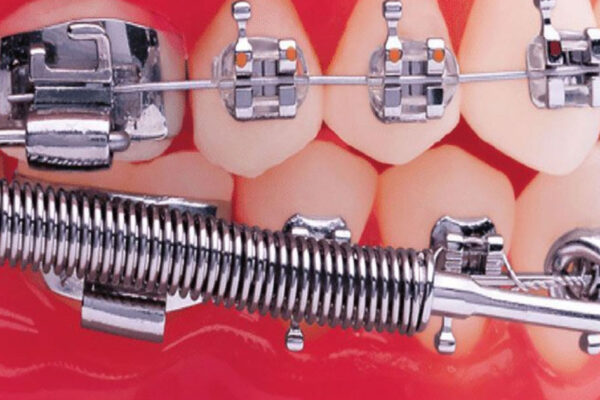While there are multiple kinds of procedures and appliances that can help to correct an overbite and straighten teeth, most clients opt for methods that are discreet and efficient. That’s where Forsus comes in. At Robison Orthodontics, we’re proud to offer the Forsus appliance for clients looking to correct their bite and straighten their teeth comfortably without having to use headgear.
What Is Forsus?
The Forsus Fatigue Resistance Device, also referred to as the Forsus device, is a piece of orthodontic equipment designed to eliminate overbites, improve the overall fit of the teeth, and help to reduce the possibility of jaw surgery in the future. The device uses springs to correct the way that a patient’s teeth come together in the mouth, which helps to move the jaw into a better position and improve their bite. It features springs that attach to upper and lower teeth as well as an open-coil spring design to help make maintaining oral hygiene easier.
Forsus: Alternative to Headgear
However, instead of using external equipment to help apply that pressure, Forsus uses springs on the inside of the mouth to exert pressure and move the teeth and jaw. Like headgear, they also work in combination with braces. They don’t require extra external parts.

Benefits of Using the Forsus Appliance
Using the Forsus Fatigue Resistance Device comes along with a variety of advantages for the patient.
It’s Discreet
One of the most significant benefits of using the Forsus device is that it offers patients the ability to correct their overbite and fix their teeth discreetly. For many years, headgear was one of the only ways younger people with overbites could try to correct their jaw without surgery. Unfortunately, headgear is far from unobtrusive. As time has gone on and technology has advanced, new and more convenient methods for fixing overbites have been created, including the Forsus device. Forsus easily blends in with braces and is only installed on the inside of the mouth, with no intrusive or external parts.
It’s Simple
Unlike other appliances that require daily or weekly maintenance, Forsus is an incredibly simple device. It only requires an initial installation; then, treatment can immediately begin. Because the device is designed to apply consistent pressure on the teeth and jaw, there’s no need for constant checkups to tighten or change your equipment. This gives you more independence, as you won’t constantly need to arrange follow-up orthodontist appointments to address your headgear.
It Straightens Teeth
Forsus is designed to work in combination with braces, meaning that it also becomes an incredibly helpful tool to straighten the teeth. Because you need to move teeth to move the jaw, Forsus works to push your top teeth back and your bottom teeth forward. Ultimately, this moves the jaw and helps the teeth fit more comfortably in the mouth. This also helps ensure braces can move teeth into place and straighten them.
It’s Comfortable
For years, the primary options to fix an overbite were headgear or jaw surgery. Unfortunately, neither of these options is extraordinarily comfortable, whether you’re a child or an adult. Fortunately, the discreet design on the inside of the mouth also enables the Forsus device to be more comfortable than either option.
With headgear, many people struggle to be comfortable throughout the day because their equipment is consistently in the way. With Forsus, there are no jutting, sharp parts that protrude into the side of the mouth, and there are also no external pieces required.
It Allows for Easy Cleaning
Another advantage of the Forsus Fatigue Resistance Device is that it was designed with convenience in mind. Equipment like headgear can be difficult to clean, which is why the Forsus appliance has an open coil spring design that gives you easy access to your mouth and allows you to clean your teeth and equipment properly. This smart design also helps to combat food that would normally get stuck in large equipment gaps.
Should I Choose Forsus?

When it comes to choosing what kind of orthodontic appliance works best for you, the answer will depend on your unique jaw placement, the severity of your overbite or misalignment, and the specific treatment you need.
The Forsus Fatigue Resistance Device may be best for you or your child if one of the following is true:
You Have an Overbite that Needs to Be Fixed
When you have an overbite, you have limited options for eliminating it. As mentioned, before Forsus, options for an overbite typically only included headgear, braces, or some form of jaw surgery. Forsus, however, has become one of the most popular methods for fixing overbites because it is discreet, comfortable, and incredibly efficient. If you have an overbite, talk to your orthodontist about how Forsus can work for you.
You’re Looking for an Alternative to Headgear
Dealing with an overbite isn’t ideal, especially when the only two options for correcting it can be uncomfortable at best. Fortunately, headgear doesn’t have to be your only option. Headgear can be difficult to maintain and require additional orthodontist appointments.
Forsus, on the other hand, makes an incredible alternative to headgear because it can fix jaw placements in growing patients without the need for external headgear and repeated orthodontist visits.
You’re Still Growing / You Think You’re Too Old to Have Your Bite Fixed
That’s right; Forsus is uniquely ideal for both children and adults. Unlike other appliances, including headgear, Forsus can be used on both children and adults who have overbites. Because headgear was designed to be used by children who still have growing bones, it may not be suitable for adults with mature bones.
Forsus was created with a focus on helping overbites in a patient of any age. Forsus makes an effective, discreet, and comfortable option for children who don’t want the attention headgear or surgery brings, and it can do just the same for adults.
How Do You Brush Your Teeth with Forsus Springs?
While brushing your teeth may seem like a confusing endeavor with an appliance in your mouth, the design of the Forsus Fatigue Resistance Device helps make keeping your teeth clean easy. It’s important to note that you should try to brush your teeth after each meal, which is the recommendation for any dental patient. However, brushing is especially important when you have headgear or Forsus, so you can avoid plaque growing between your equipment and your teeth.
With its open spring coil design, you can clean your teeth while wearing Forsus as you normally would with braces. Follow these steps.
1. Brush Your Teeth Regularly with a Fluoride Toothpaste
As mentioned, brushing your teeth regularly is vital in maintaining your oral hygiene. When you have orthodontic appliances in your mouth, making sure that you take good care of your teeth is even more important. You should gently brush your teeth with fluoride toothpaste 2-3 times every day when you have Forsus installed. This way, you can fight plaque buildup and make sure other issues, like food getting caught in the appliance, are eliminated.
2. Don’t Forget to Floss
While flossing is an often-ignored component of a dental hygiene routine, it is even more important when you have braces and an extra appliance in your mouth. Fortunately, with Forsus, flossing is possible. You’ll want to do your best to floss the teeth connected to your appliance to avoid plaque buildup and prevent potential cavities. Flossing is also a major tool in ensuring nothing gets stuck in your braces or your Forsus after you eat.
3. Try a Waterpik
Brushing and flossing are both essential, but you might need a little extra help to make sure your teeth and appliances are as clean as possible. Alternatively, you may find that you prefer the peace of mind that comes with knowing there is no food or debris lodged in your Forsus or braces. Many patients opt to use water flossing tools like Waterpiks to target problem areas of the mouth and ensure they’re free of food and plaque.
Forsus FAQs
The Forsus appliance has been proven to be incredibly effective in both improving jaw placement and straightening teeth. Typical treatment time lasts around six months and can make a massive difference in your side profile and jaw placement rather quickly.
Because the Forsus device pushes and pulls teeth to move the jaw, it can swiftly improve the location of the jaw, straighten the teeth, and make them fit more comfortably in the mouth. By applying constant force day and night, Forsus can work quickly and produce the results you want within months
When eating larger, crunchier foods that require biting into, such as apples or bagels, it’s recommended that you eat with caution or cut the food into smaller pieces. You may also consider avoiding these foods when possible, as they may also get caught in braces.
If something happens that causes your spring to fall off completely, it’s best to go to your orthodontist as soon as possible to have them rewire it properly.

Forsus Can Help Straighten Your Teeth and Fix Your Jaw

If you or your child have an overbite and headgear is not for you, don’t wait to see how the Forsus Fatigue Resistance Device can help you address your overbite comfortably and quickly. To learn more about the Forsus appliance or the other services available at Robison Orthodontics, contact us for a free consultation.

Dr. Tyler Robison is an alum of Mesa’s Mountain View High School. He graduated from Brigham Young University before being accepted to the “Top Ten-nationally ranked” University of Louisville in Kentucky, where he earned his Doctorate in Dental Medicine and a Master’s Degree in Oral Biology. He graduated with honors in the top ten percent of his class. Dr. Robison continued at the University of the Pacific in San Francisco, where he received a second master’s degree in dental science and his orthodontic certification.


